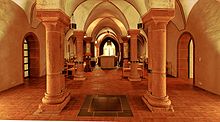crypt




A crypt ( ancient Greek κρύπτη krýptē , German , 'hidden passage, vault, crypt ' ), sometimes also referred to as a lower church , is a room located under the choir ( apse ) or below the altar of Christian churches, which is usually for holy tombs (also reliquary shrines ) and altars served. According to early Christian custom, the relics of a martyr were initially located in the crypt .
history
The early Christian underground tombs in front of the walls of ancient Rome are considered to be the forerunners of the crypt ( ancient Greek κρυπτός kryptós , German 'hidden, secret' ) . Churches were later built over some of these graves, such as B. Alt-St. Peter in Rome, which is said to have been built on the tomb of the disciple Peter . In most cases the tomb is located under the apse , in the Romanesque sometimes under the western choir . The actual holy grave under the altar can be designed as a small, inaccessible chamber, which can be viewed through a small vestibule called the Confessio .
The first crypts were created in tunnels, which is why they are called "gallery crypt". In order to create closeness to the grave, the tunnel was allowed to follow the apse, creating a passage around the grave. This shape is called the "ring crypt". The first ring crypt can be found in Alt-St. Peter around 590. The outer crypt was built as an extension to the ring crypt, in which mainly clergy dignitaries were buried, which made altars necessary for memorial services. The first outer crypt is found in Brixworth , England , it was built in the early 8th century. The heyday of the crypt as a structural form was the Romanesque, in the form of the hall crypt, which developed from the ring crypt with outer crypt.
The hall crypt has multiple aisles and often extends below the transept of the church. Their height made it necessary to raise the choir. The hall crypt of the Speyer Cathedral is z. B. seven meters high and has seven altar niches, creating a "lower church". The construction of many crypts is likely to go back to rulers 'wishes to be buried close to saints' graves. With the advent of the Gothic, the crypt disappeared, as martyrs and their relics were now kept in shrines and openly displayed above ground in communal choirs and the princely memorial culture now took place in more public areas of the church building. Churches of reform and mendicant orders usually do not have crypts, as they were not built over saints' graves, the same applies almost without exception to simple parish churches.
Important crypts
- Crypt in San Zeno Maggiore , Verona
- Crypt of the Monument to the Battle of the Nations in Leipzig
- Crypts in the Basilica of St. Emmeram ( Regensburg , Germany): Ring crypt (before 791), Ramwold's crypt (around 980) and Wolfgang's crypt (1052)
- Crypts of St. Michael (1010-1015), the Mariendome (872) and St. Mauritius (1058-1072) in Hildesheim
- Crypt of the St. Matthias Basilica with the Apostle's grave in Trier
- Crypt of the Paderborn Cathedral
- Crypt of the main church St. Michaelis (Hamburg)
- Crypt of the Brunswick Cathedral
- Crypt of Mönchengladbach Minster
- Crypt of the Speyer Cathedral
- Crypt of the Fulda Cathedral
- Crypt of the Freising Cathedral
- Crypt in Neuenberg Monastery
- Crypt of the collegiate church St. Servatius (Quedlinburg) (around 1070)
- Crypt in Gurk Cathedral ( Carinthia , Austria )
- Crypt in Schlägl Abbey ( Upper Austria , Austria)
- Crypt in Lund Cathedral ( Sweden )
- Crypt in St. Peter's Basilica ( Rome , Italy ), see Vatican Grottoes
- Crypt of the Basilica Pontificia di San Nicola ( Bari , Italy )
- Matthias Church (Budapest) crypt , Hungary
- Leonhard's Crypt in Wawel Cathedral ( Krakow , Poland , around 1038)
- Crypt of San Antolín in the Cathedral of Palencia , Spain
- Crypt of the Peterskirche Görlitz
- Crypt of the Abbey Church of St-Victor in Marseille with a collection of early Christian sarcophagi
- Crypt of St. Andreas, Cologne with the Roman sarcophagus of Albertus Magnus . Unusual: the Romanesque crypt was filled in in the late Middle Ages and exposed during the reconstruction after World War II and given new pillars.
- Double crypt in the cathedral in Apt , Provence, France
See also
literature
- Ulrich Rosner: The Ottonian Crypt (= publications of the Department of Architectural History of the Art History Institute of the University of Cologne. Volume 40). University of Cologne , Cologne 1991, DNB 920497829 (Zugl .: Cologne, Univ., Diss., 1991).
- Uwe Lobbedey: Ottonian crypts. Comments on the state of research based on selected examples. In: Gerd Althoff , Ernst Schubert (ed.): Representation of the rulers in Ottonian Saxony (= Constance working group for medieval history: lectures and research. Volume 46) [Conference of the Constance working group for medieval history from 22. – 25. March 1994]. Sigmaringen 1998, ISBN 3-7995-6646-5 , pp. 77-102.
- Günther Binding : Sources, fountains and reliquary graves in churches. In: Journal of Archeology of the Middle Ages. 3, 1975, ISSN 0340-0824 , pp. 37-56.
Web links
Individual evidence
- ↑ Crypt, the. In: Digital dictionary of the German language . Retrieved August 2, 2019
- ↑ Martin Möhle: The crypt as the ruler's chapel. In: Archives for cultural history . 73, 1991, p. 1 ff. ( Digizeitschriften.de [restricted access]).
